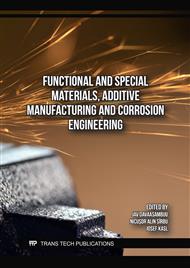[1]
C. Vălean, E. Linul, D.K. Rajak, Compressive performance of 3D-printed lightweight structures: Infill pattern optimization via Multiple-Criteria Decision Analysis method, Results Eng. 25 (2025) 103936.
DOI: 10.1016/j.rineng.2025.103936
Google Scholar
[2]
D.A. Șerban, A.V. Coșa, G. Belgiu, R. Negru, Failure locus of an ABS-based compound manufactured through photopolymerization, Polym. 14(18) (2022) 3822.
DOI: 10.3390/polym14183822
Google Scholar
[3]
M. Petousis, N. Vidakis, N. Mountakis, E. Karapidakis, A. Moutsopoulou, Functionality versus sustainability for PLA in MEX 3D printing: The impact of generic process control factors on flexural response and energy efficiency, Polym. 15 (2023) 1232.
DOI: 10.3390/polym15051232
Google Scholar
[4]
G. Epasto, F. Distefano, L. Gu, et al., Design and optimization of Metallic Foam Shell protective device against flying ballast impact damage in railway axles, Mater. Des. 196 (2020) 109120.
DOI: 10.1016/j.matdes.2020.109120
Google Scholar
[5]
D.G. Zisopol, M. Minescu, D.V. Iacob, A Study on the Influence of FDM Parameters on the Compressive Behavior of PET-G Parts, Eng. Technol. Appl. Sci. Res. 14(2) (2024) 13592-7.
DOI: 10.48084/etasr.7063
Google Scholar
[6]
N. Vidakis, M. Petousis, E. Karapidakis, N. Mountakis, C. David, D. Sagris, Energy consumption versus strength in MEΧ 3D printing of polylactic acid, Adv. Ind. Manuf. Eng. 6 (2023) 100119.
DOI: 10.1016/j.aime.2023.100119
Google Scholar
[7]
C. Vălean, E. Linul, G. Palomba, G. Epasto, Single and repeated impact behavior of material extrusion-based additive manufactured PLA parts, J. Mater. Res. Technol. 30 (2024) 1470-1481.
DOI: 10.1016/j.jmrt.2024.03.150
Google Scholar
[8]
D.A. Șerban, C. Marșavina, A.V. Coșa, G. Belgiu, R. Negru, A study of yielding and plasticity of rapid prototyped ABS, Math. 9(13) (2021) 1495.
DOI: 10.3390/math9131495
Google Scholar
[9]
C. Vălean, L. Marșavina, E. Linul, Compressive behavior of additively manufactured lightweight structures: infill density optimization based on energy absorption diagrams, J. Mater. Res. Technol. 33 (2024) 4952-4967.
DOI: 10.1016/j.jmrt.2024.10.143
Google Scholar
[10]
D.G. Zisopol, M. Minescu, D.V. Iacob, A study on the influence of FDM parameters on the tensile behavior of samples made of PET-G, Eng. Technol. Appl. Sci. Res. 14(2) (2024)13487-92.
DOI: 10.48084/etasr.6949
Google Scholar
[11]
V. Cojocaru, D. Frunzaverde, C. Miclosina, G. Marginean, The influence of the process parameters on the mechanical properties of PLA specimens produced by fused filament fabrication A review, Polym. 14(5) (2022) 886.
DOI: 10.3390/polym14050886
Google Scholar
[12]
D.I. Stoia, E. Linul, Tensile, flexural and fracture properties of MEX-printed PLA-based composites, Theor. Appl. Fract. Mech. 132 (2024) 104478.
DOI: 10.1016/j.tafmec.2024.104478
Google Scholar
[13]
J.D. Kechagias, N. Vidakis, M. Petousis, N. Mountakis, A multi-parametric process evaluation of the mechanical response of PLA in FFF 3D printing, Mater. Manuf. Processes 38(8) (2023) 941-953.
DOI: 10.1080/10426914.2022.2089895
Google Scholar
[14]
D.G. Zisopol, A.I. Portoaca, I. Nae, I. Ramadan, A comparative analysis of the mechanical properties of annealed PLA, Eng. Technol. Appl. Sci. Res. 12(4) (2022) 8978-81.
DOI: 10.48084/etasr.5123
Google Scholar
[15]
C. Vălean, M. Baban, D.K. Rajak, E. Linul, Effect of multiple process parameters on optimizing tensile properties for material extrusion-based additive manufacturing, Constr. Build. Mater. 414 (2024) 135015.
DOI: 10.1016/j.conbuildmat.2024.135015
Google Scholar
[16]
A. Milovanović, S.-V. Galațanu, A. Sedmak, L. Marșavina, I. Trajković, C.-F. Popa, Layer thickness influence on impact properties of FDM printed PLA material, Procedia Struct. Integr. 56 (2024) 190-197.
DOI: 10.1016/j.prostr.2024.02.055
Google Scholar
[17]
C. Valean, D.I. Stoia, C. Opris, E. Linul, Effect of fillers on mechanical properties of FDM printed PLA components, Procedia Struct. Integr. 56 (2024) 97–104.
DOI: 10.1016/j.prostr.2024.02.043
Google Scholar
[18]
S. Salamatian Hosseini, A. Nabavi-Kivi, M.R. Ayatollahi, M. Petru, Effect of nozzle diameter on tensile and fracture behavior of FDM-PLA samples, Procedia Struct. Integr. 61(2024)20-25.
DOI: 10.1016/j.prostr.2024.06.004
Google Scholar
[19]
L. Marșavina, C. Vălean, M. Mărghitaș, et al., Effect of the manufacturing parameters on the tensile and fracture properties of FDM 3D-printed PLA specimens, Eng. Fract. Mech. 274 (2022) 108766.
DOI: 10.1016/j.engfracmech.2022.108766
Google Scholar
[20]
D. Rahmatabadi, I. Ghasemi, M. Baniassadi, K. Abrinia, M. Baghani, 3D printing of PLA-TPU with different component ratios: fracture toughness, mechanical properties and morphology, J. Mater. Res. Technol. 21 (2022) 3970-3981.
DOI: 10.1016/j.jmrt.2022.11.024
Google Scholar
[21]
N. Vidakis, M. Petousis, N. Mountakis, V. Papadakis, C. Charou, V. Rousos, P. Bastas, Glass fillers in three different forms used as reinforcement agents of polylactic acid in material extrusion additive manufacturing, Appl. Sci. 13(11) (2023) 6471.
DOI: 10.3390/app13116471
Google Scholar
[22]
C. Vălean, I.N. Orbulov, A. Kemény, E. Linul, Low-cycle compression-compression fatigue behavior of MEX-printed PLA parts, Eng. Fail. Anal. 161 (2024) 108335.
DOI: 10.1016/j.engfailanal.2024.108335
Google Scholar
[23]
ASTM D5045-14, Standard Test Methods for Plane-Strain Fracture Toughness and Strain Energy Release Rate of Plastic Materials, 2022. 5acXjzUk
DOI: 10.1520/d5045-14r22
Google Scholar


